| Latest | Greatest | Lobby | Journals | Search | Options | Help | Login |
|
|
|
This topic is archived. |
| Home » Discuss » Topic Forums » Sports |
|
| Jack Rabbit
|
Sat Jun-21-08 12:31 AM Original message |
| The Jack Rabbit Chess Report (June 21): Magnus, Ivanchuk 1-2 in Foros |
|
Edited on Sat Jun-21-08 12:52 AM by Jack Rabbit
Magnus wins the Aerosvit
 Seventeen-year-old grandmaster Magnus Carlsen of Norway won the third annual Aerosvit International Tournament Thursday in Foros, Crimea (Ukraine) with 8 points out of a possible eleven. Magnus, who was leading by two points at the end of last weekend, finished one point ahead of Ukrainian grandmaster Vassily Ivanchuk, at 39 the oldest player in the field, who charged up the table in the final rounds, winning three of his last four games. Magnus defeated Ivanchuk in the first round in the game that proved to be the entire difference in the tournament. Foros completes a productive spring for both Magnus and Ivanchuk. Magnus won the first leg of the FIDE Grand Prix in Baku in early May and later in the moth scored a victory in a rapid match against Hungarian GM Peter Leko. Ivanchuk won the MTel Masters' Tournament in Sofia in mid-May and then took the annual rapid tournament in Le�n by defeating Vishy Anand in their final round mini-match. It appears that if the Foros tournament is counted in the FIDE rankings due out at the first of July, Magnus will be ranked number two and Ivanchuk, with a forty point gain over the April list, will take over the third slot. Levon Aronian takes first in Asrian Memorial  Levon Aronian, Armenia's strongest grandmaster, came from behind on the last day to win the Karen Asrian Memorial Rapid Tournament in Yerevan Tuesday. The final day started with Hungarian GM Peter Leko leading Aronian by a half point after 12 rounds. However, in round 13, Aronian, playing White, defeated British grandmaster Mickey Adams in just 20 moves while Leko, also playing White, fell to Russia's Alexander Moroaevich. With the same opponents and the colors reversed, the fourteenth-round games ended in draws. Morozevich and Israeli GM Boris Gelfand tied for third. The tournament began June 9 with the name Yerevan Giants. However, Armenian national champion Karen Asrian, a resident of Yerevan, died suddenly of a heart attack while en route to watch the first round. The tournament was renamed in Asrian's honor. Calendar New York International Open at the Marshall Chess Club in New York City, 21-26 June. Sparkassen Chess Meeting, Dortmund June 28-July 6. Competitors are former world champion Vladimir Kramnik, Shakhriyar Mamedyarov, Vassily Ivanchuk, Peter Leko, Loek van Wely, Ian Nepomniachtchi, Arkadij Naiditsch and Jan Gustafsson. World Open, Philadelphia June 30-July 6. Biel Chess Festival 19 July-1 August. This year's GM tournament features Magnus Carlsen, Evgeny Alekseev, Lenier Dom�nguez, Etienne Bacrot, Alex Onischuk and Yannick Pelletier. Canadian Open, Montreal 19-28 July. Politiken Cup, Copenhagen 19-27 July. British Championship, Liverpool 27 July-9 August. Mainz Chess Festival 28 July-3 August. FIDE Grand Prix, Sochi 30 July-15 August. Howard Staunton Memorial Tournament, London at historic Simpson's Divan, 7-18 August. Competitors: Mickey Adams (defending champion), Nigel Short, Jon Speelman, Peter Wells, Bob Wade, Jan Timman, Loek van Wely, Jan Smeets, Erwin L'Ami, Jan Werle and Alexander Cherniaev FIDE Women's Knock Out (World Women's Chess Championship), Nalchik, Kabardino-Balkaria (Russia) 28 August-18 September. Anand-Kramnik World Championship Semifinal Match, Bonn October 14-November 2. Twelve rounds. European Club Cup, Kallithea (Greece) 16-24 October. Asian Championships, Tehran 21-30 October. Chess Olympiad, Dresden 12-25 November. Topalov-Kamsky World Championship Semifinal Match, Lvov 26 November-15 December. Twelve Rounds. FIDE Grand Prix, Doha 13-29 December. |
| Printer Friendly | Permalink | | Top |
| Jack Rabbit
|
Sat Jun-21-08 12:32 AM Response to Original message |
| 1. Games from Recent Events |
|
Your humble hare acknowledges the assistance of Fritz 6.0 on analysis. Diagrams on the Jack Rabbit Chess Report are made with Chess M�rida, a true type font that can be downlaoded free here. !""""""""# $tMvWlVmT% $OoOoOoOo% $ + + + +% $+ + + + % $ + + + +% $+ + + + % $pPpPpPpP% $RnBqKbNr% /(((((((() WHITE White to move (This position is a theoretical draw) |
| Printer Friendly | Permalink | | Top |
| Jack Rabbit
|
Sat Jun-21-08 12:36 AM Response to Reply #1 |
| 2. Nisipeanu - Carlsen, Round 7, Foros |
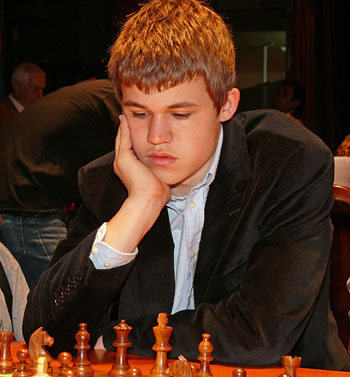 Magnus Carlsen Liviu-Dieter Nisipeanu - Magnus Carlsen Aerosvit International Tournament, Round 7 Foros, Crimea (Ukraine), 15 June 2008 Open Sicilian Game: Rat Dragon Defense 1.e4 c5 2.Nf3 d6 3.d4 cxd4 4.Nxd4 Nf6 5.Nc3 g6
6.Be2 Bg7 7.0-0 Nc6
8.Nb3 0-0 9.Kh1 a6
10.f4 b5 11.Bf3 Bb7
12.a4!?
12...b4
13.Nd5 Nxd5
14.exd5 Na5 15.c3?
15...bxc3 16.bxc3
!""""""""# $t+ W Tl+% $+v+ OoVo% $o+ O +o+% $M +p+ + % $p+ + P +% $+nP +b+ % $ + + +pP% $R Bq+r+k% /(((((((() WHITE: Liviu-Dieter Nisipeanu Position after 16.bc3:p 16...Rc8!
17.Rb1 Ba8!
18.Nd2 Nc4 19.Nxc4 Rxc4 20.Bd2
20...Qa5 21.Qe1
21...Bxd5 22.Be2
!""""""""# $ + + Tl+% $+ + OoVo% $o+ O +o+% $W +v+ + % $p+t+ P +% $+ P + + % $ + Bb+pP% $+r+ Qr+k% /(((((((() WHITE: Liviu-Dieter Nisipeanu Position after 22.Bf3e2 22...Qxa4!!
23.Bxc4 Bxc4 24.Rf2
24...e6 25.Be3
25...Bd5 26.Rfb2
26...Qe4 27.Qd2 h5!
28.Bd4 Bh6 29.Be3
!""""""""# $ + + Tl+% $+ + +o+ % $o+ Oo+oV% $+ +v+ +o% $ + +wP +% $+ P B + % $ R Q +pP% $+r+ + +k% /(((((((() WHITE: Liviu-Dieter Nisipeanu Position after 29.Bd4e3 29...a5!
30.Rb8
30...Kh7 31.h3 Rxb8
32.Rxb8 Bg7!
33.Bd4 Bxd4 34.cxd4
34...a4
35.Kh2 a3 36.Rb4 a2 37.Ra4 Qb1 0-1
|
| Printer Friendly | Permalink | | Top |
| Jack Rabbit
|
Sat Jun-21-08 12:37 AM Response to Reply #1 |
| 3. Shirov - Ivanchuk, Round 8, Foros |
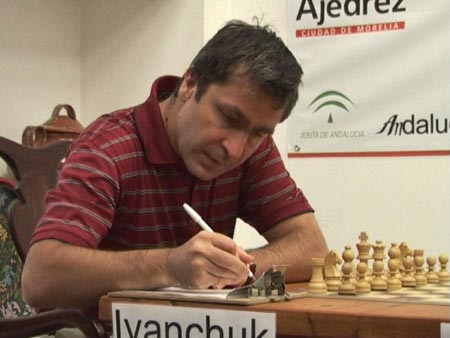 Vassily Ivanchuk Alexei Shirov - Vassily Ivanchuk Aerosvit International Tournament, Round 8 Foros, Crimea, (Ukraine), 16 June 2008 West India Game: Indian Queen's Gambit (Exchange Opening) Gr�nfeld Defense) 1.d4 Nf6 2.c4 g6 3.Nc3 d5 4.cxd5 Nxd5 5.Bd2!?
5...Bg7 6.e4 Nb6 7.Be3 0-0 8.Bb5
8...Qd6!?
!""""""""# $tMvW Tk+% $OoO OoVo% $ M + +o+% $+b+ + + % $ + Pp+ +% $+ N B + % $pP + PpP% $R +qK Nr% /(((((((() WHITE: Alexei Shirov Position after 8...Qd8d6 9.Nge2
9...c6
10.Bd3 e5
11.dxe5
11...Qxe5 12.Bd4 Qe7 13.Bxg7 Kxg7 14.Bc2 Rd8
15.Qc1 Na6 16.0-0 Be6 17.Nf4 Bc4 18.Re1 Nb4 19.a3
19...Nxc2 20.Qxc2 Qf6
21.Nce2 Rd7 22.b3!?
22...Ba6
23.Rad1 Rad8 24.g3?!
24...Qe5
25.f3 Kg8?!
26.a4
26...h5 27.Kf2 Rd6 28.Qc3?
28...Nd7!
29.Rxd6 Qxd6 30.Rc1
30...Ne5!
31.h4 Qf6 32.b4
!""""""""# $ + T +l+% $Oo+ +o+ % $v+o+ Wo+% $+ + M +o% $pP +pN P% $+ Q +pP % $ + +nK +% $+ R + + % /(((((((() WHITE: Alexei Shirov Position after 32.b3b4 32...Rd3!!
33.Nxd3
33...Qxf3+ 34.Kg1 Bxd3 35.Qxe5 Qe3+ 36.Kh2 Qxe2+ 0-1
|
| Printer Friendly | Permalink | | Top |
| Jack Rabbit
|
Sat Jun-21-08 12:41 AM Response to Reply #1 |
| 4. Onischuk - Eljanov, Round 7, Foros |
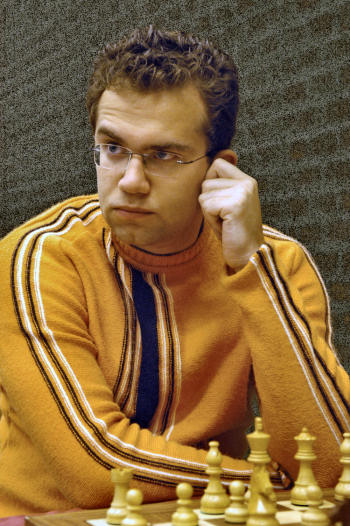 Pavel Eljanov Alex Onischuk - Pavel Eljanov Aerosvit International Tournament, Round 7 Foros, Crimea (Ukraine), 15.06.2008 East India Game: Queen's Indian Defense (Bronstein Variation) 1.d4 Nf6 2.c4 e6 3.Nf3 b6 4.g3 Ba6 5.Qa4!?
5...Bb7 6.Bg2 c5 7.dxc5
7...bxc5
8.0-0 Be7 9.Nc3 0-0 10.Rd1
10...d6 11.Bf4 Qb6 12.Rd2
12...h6
13.Rad1 e5 14.Be3 Nc6 15.Qb5 Qc7 16.Qb3
16...a6 17.Nh4 Rfb8!?
18.Bxc6?
!""""""""# $tT + +l+% $+vW VoO % $ +bO M O% $+ O O + % $ +p+ + N% $+qN B P % $pP RpP P% $+ +r+ K % /(((((((() WHITE: Alex Onischuk Position after 18.Bg2c6:N 18...Qxc6
19.f3 e4
20.Qc2 Re8 21.fxe4 Qc8!
22.Nf3 Qh3
23.Kh1 Bf8 24.Rd5
24...Bxd5 25.cxd5 Ng4 26.Bg1
26...g6 27.e5
27...Nxe5 28.Ne4
28...Ng4 29.Nh4 Rab8 30.Ng2 Rxe4
31.Qxe4 !""""""""# $ T + Vk+% $+ + +o+ % $o+ P +oO% $+ Op+ + % $ + +q+m+% $+ + + Pw% $pP +p+nP% $+ +r+ Bk% /(((((((() WHITE: Alex Onischuk Position after 31.Qc2e4:R 31...Qxh2+!!
32.Bxh2 Nf2+ 33.Kg1 Nxe4 34.b3 h5
35.Rc1 Bg7 36.Rc2 g5 37.Ne1 Re8 38.Kf1
38...Nc3 39.Rd2 g4 40.Ng2 Bh6 0-1
|
| Printer Friendly | Permalink | | Top |
| Jack Rabbit
|
Sat Jun-21-08 12:45 AM Response to Reply #1 |
| 5. Shirov-Karjakin, Round 7, Foros |
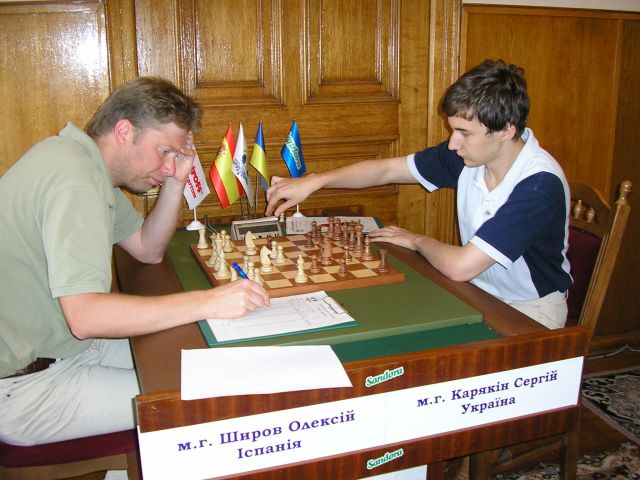 Alexei Shirov and Sergey Karjakin Alexey Shirov - Sergey Karjakin Aerosvit International Tournament, Round 6 Foros, Crimea (Ukraine), 13 June 2008 Semi-Slav Queen's Gambit: Moscow Defense 1.d4 d5 2.c4 c6 3.Nf3 Nf6 4.Nc3 e6 5.Bg5 h6
6.Bh4
6...dxc4 7.e4 g5 8.Bg3 b5 9.Be2 Bb7 10.0-0
10...Nbd7 11.Ne5 Bg7 12.Nxf7!?
12...Kxf7 13.e5 Nd5 14.Ne4 Qb6!?
15.Nd6+ Ke7 16.Bg4 h5!?
!""""""""# $t+ + + T% $Ov+mL V % $ WoNo+ +% $+o+mP Oo% $ +oP +b+% $+ + + B % $pP + PpP% $R +q+rK % /(((((((() WHITE: Alexei Shirov Position after 16...h6h5 17.Bxh5!
17...Raf8 18.Qg4 Bh6 19.h4 Rhg8
20.hxg5 Bxg5 21.Ne4 Ne3
22.Qxg5+ Rxg5 23.Bh4 Kd8 24.fxe3
24...Rh8 25.Bxg5+ Kc7 26.Bg4
26...c5
27.dxc5 Nxc5 28.Rf7+ !""""""""# $ + + + T% $OvL +r+ % $ W +o+ +% $+oM P B % $ +o+n+b+% $+ + P + % $pP + +p+% $R + + K % /(((((((() WHITE: Alexei Shirov Position after 28.Rf1f7+ 28...Kb8!
29.Nd6 Rg8 30.Raf1!
30...Rxg5 31.Rf8+ Kc7 32.R1f7+ Nd7 33.Rxd7+
33...Kxd7 34.Rf7+ Kd8
35.Rf8+ Kd7 36.Rf7+ �-�
|
| Printer Friendly | Permalink | | Top |
| Jack Rabbit
|
Sat Jun-21-08 12:47 AM Response to Reply #1 |
| 6. Aronian - Adams, Asrian Memorial, Round 13, Yerevan |
 Levon Aronian Levon Aronian - Mickey Adams Karen Asrian Memorial Tournament, Round 13 Yerevan, 15 June 2008 East India Game: Queen's Indian Defense (Old Main Line) 1.d4 Nf6 2.c4 e6 3.Nf3 b6 4.g3 Bb7
5.Bg2 Be7 6.0-0 0-0 7.Re1
7...Na6
8.Ne5
8...d5
9.cxd5 exd5 10.Nc3 c5 11.dxc5
11...Nxc5 12.Be3 Re8 13.Nd3 Ne6
14.Rc1 Ne4
15.Qa4 Bf6
16.Nxe4!?
16...dxe4 17.Red1 exd3??
!""""""""# $t+ Wt+k+% $Ov+ +oOo% $ O +mV +% $+ + + + % $q+ + + +% $+ +oB P % $pP +pPbP% $+ Rr+ K % /(((((((() WHITE: Levon Aronian Position after 17...ed3:N 18.Bxb7!
18...Nd4
19.Bxd4 dxe2 20.Re1 1-0
|
| Printer Friendly | Permalink | | Top |
| Jack Rabbit
|
Sat Jun-21-08 12:49 AM Response to Original message |
| 7. In Memoriam Karen Asrian: Asrian - Pashikian, Armenian Championships, Yerevan, 2006 |
|
Karen Asian was the reigning Armenian national champion when he died suddenly on June 9 of a heart attack in Yerevan. He was only 28 years old.
This may have been his best game. 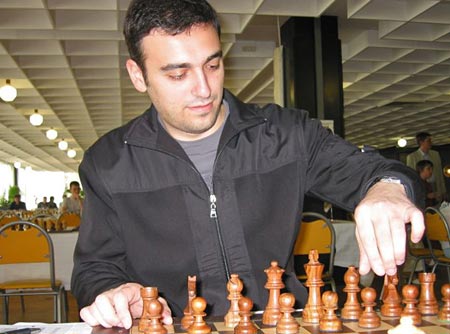 Karen Asrian Karen Asrian - Arman Pashikian Armenian National Championship, Round 4 Yerevan, 19 March 2006 Spanish Petit Royal Game: Neo-Classical Defense 1.e4 e5 2.Nf3 Nc6 3.Bb5 Nf6 4.d3
4...Bc5 5.c3 0-0 6.Bg5 Re8
7.Nbd2 h6 8.Bh4 Be7 9.0-0!?
9...d6 10.a4
10...a6 11.Bc4 Nh5
12.Bg3
12...g6
13.h3 Rf8
14.Bh2 Bg5
15.Nxg5 hxg5?!
16.Re1 Kg7 17.Nf1
17...Nf4 18.Ne3 Rh8 19.d4 Bxh3?!
20.gxh3 Nxh3+ 21.Kf1 Nf4
22.Bxf4 gxf4 !""""""""# $t+ W + T% $+oO +oL % $o+mO +o+% $+ + O + % $p+bPpO +% $+ P N + % $ P + P +% $R +qRk+ % /(((((((() WHITE: Karen Asrian Position after 22.gf4:B 23.Qf3!?
23...Qd7
24.dxe5 Rh4 25.e6!
25...fxe6 26.Ng4 e5 27.Be2 Nd8?!
28.Kg2 Nf7 29.Rh1 Rah8
30.Rxh4 Rxh4 31.Rh1 Ng5?
!""""""""# $ + + + +% $+oOw+ L % $o+ O +o+% $+ + O M % $p+ +pOnT% $+ P +q+ % $ P +bPk+% $+ + + +r% /(((((((() WHITE: Karen Asrian Position after 31...Nf7g5 32.Rxh4!!
32...Nxf3 33.Rh7+!
33...Kxh7 34.Nf6+ Kg7 35.Nxd7
35...Ng5 36.c4 Kf7 37.c5 Ke7 38.c6 b6
39.Bxa6 f3+ 40.Kg3 Nxe4+ 41.Kxf3 d5 42.Nxe5 1-0
|
| Printer Friendly | Permalink | | Top |
| Jack Rabbit
|
Sat Jun-21-08 10:14 AM Response to Original message |
| 8. Anand essay appears in Time Magazine |
|
From Time Magazine
Dated June 30, 2008 The Indian Defense By Viswanathan Anand Where did chess begin? For many who play the sport at its highest, most obsessive levels, that's not just a question of history � it's a matter of ownership, of dominion. We're so completely lost in our universe of 64 black and white squares that we like to think every move we make changes the way the world exists. So it's easy for Russians to imagine that chess began when they started to play it. In 1991, at my first international tournament, in Reggio Emilia in northern Italy, a Russian grandmaster condescendingly told me I could at best be a coffee-house player because I had not been tutored in the Soviet school of chess, which then dominated the sport. With the arrogance of youth � I was 21 � I thought to myself, "But didn't we Indians invent chess? Why shouldn't I have my own route to the top of the sport?" Read more at the link. |
| Printer Friendly | Permalink | | Top |
| DU
AdBot (1000+ posts) |
Tue Apr 30th 2024, 01:53 PM Response to Original message |
| Advertisements [?] |
| Top |
| Home » Discuss » Topic Forums » Sports |
|
Powered by DCForum+ Version 1.1 Copyright 1997-2002 DCScripts.com
Software has been extensively modified by the DU administrators
Important Notices: By participating on this discussion board, visitors agree to abide by the rules outlined on our Rules page. Messages posted on the Democratic Underground Discussion Forums are the opinions of the individuals who post them, and do not necessarily represent the opinions of Democratic Underground, LLC.
Home | Discussion Forums | Journals | Store | Donate
About DU | Contact Us | Privacy Policy
Got a message for Democratic Underground? Click here to send us a message.
© 2001 - 2011 Democratic Underground, LLC